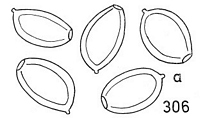|
 Agrocybe sp. 2 Agrocybe sp. 2
SynonymsAgaricus strophosus
Hebeloma strophosum
BiostatusPresent in region - Origin uncertain
Images (click to enlarge)
Caption: 306-Agrocybe sp. [Hebeloma strophosum]: a. spores. |
Article: Watling, R.; Taylor, G.M. (1987). Observations on the Bolbitiaceae: 27. Preliminary account of the Bolbitiaceae of New Zealand. Bibliotheca Mycologica 117: 61 p. + 17 pl.
Notes: A collection also in K simply labelled 'Agaricus strophosus Fries, New Zealand' is not a species of Hebeloma as would be assumed from the use of Fries' name but a species of Agrocybe. We are grateful to Egon Horak for drawing this Colenso collection, which appears to be from Wairarapa (Massee, 1898), to our attention. The collection consists of a partially expanded basidioma with distinct velar remains on both the pileus-margin and stipe. The gill-margin is badly damaged but the basidiospores are characteristically bolbitiaceous, with thick-wall and large, truncate germ-pore; the basidia are 4-spored.
It can only be assumed that the basidioma when fresh was relatively pale-coloured from the epithet chosen but it is impossible without field data to trace the relationships of this collection. The following additional data are offered:
Basidiospores 10-12 x 7-8.5 µm, ellipsoid, slightly flattened in side-view, smooth, thick-walled, ochraceous brown in water, darker in aqueous alkali solutions; germ-pore distinct, broad. Cystidia not found.
Article: Massee, G.E. (1899) [1898]. The fungus flora of New Zealand. Transactions and Proceedings of the New Zealand Institute 31: 282–349 Wellington:.
Description: Pileus subglobose, soon expanding and becoming convexo-plane and rather umbonate,
fragile, viscid when wet, disc dark-tan, even, margin pale and silky from the remains of the
veil, but not squamulose, 1.5-3 cm. across; flesh rather thin, watery; gills slightly adnexed,
ventrieose, 4-8 mm. broad, pallid, then dingy - cinnamon; spores - 7-8 x 4 µ; stem 2.5.-5 cm.
long, hollow, about 6 mm. thick, equal, fragile, pallid and becoming brownish downwards,
adpressedly silky,, with a more or less perfect silky ring near the apex.
Habitat: Grassy spots.
Distribution: Wairarapa, Northern Island, New Zealand. Europe.
Notes: Distinguished more especially by the hollow stem, which is not rooting, and the silky ring
very near to the apex of the stem.
Article: Horak, E. (1971). A contribution towards the revision of the Agaricales (Fungi) from New Zealand. New Zealand Journal of Botany 9(3): 403-462 (http://www.rsnz.org/publish/abstracts.php).
Notes: Hebeloma strophosum (Fries) Fig. 25 = Agrocybe sp.
The characters of a collection under this name at Kew ("New Zealand") indicate
that this material is not a Hebeloma. Because of the still visible ring and smooth
spores with a broad germ pore, this fungus is placed in Agrocybe. In the absence
of data on the colour and other ephemeral characters of fresh carpophores, a
reliable identification cannot be made.
|